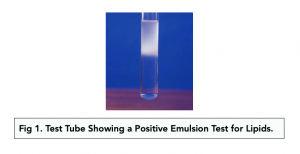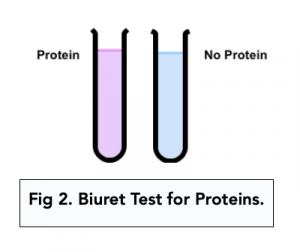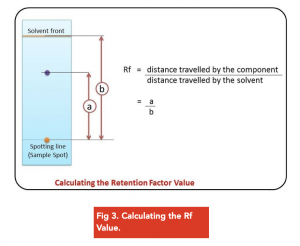Test for Lipids and Proteins (A-level Biology)
Emulsion Test: Lipids
In the previous tutorial (17 Test for Carbohydrates) we studied the non-quantitative, semi-quantitative, and quantitative methods we can use to test for carbohydrates. When you test for carbohydrates, lipids and proteins, it varies slightly. Now we will consider the emulsion test for lipids.
- Add ethanol and shake. Add ethanol to the sample, and vigorously shake for one minute.
- Pour the solution into water. Next, pour the entire solution into a test tube containing water.
- Check for formation of a milky white emulsion. Because lipids are insoluble in water, they will become immiscible, meaning they will not mix with the water. As a result, any lipids present in your sample will float to the top and form a milky white emulsion. The greater the concentration of lipids in your sample, the more apparent the milky colour will become.

Biuret Test: Proteins
We can use the biuret test to test for the presence of proteins. To perform the test, follow these steps:
- Make the solution alkaline. In order to properly test for the presence of proteins, your test solution needs to be alkaline. To make it alkaline, you need to add a few drops of sodium hydroxide (which is a base) to your solution.
- Add copper (II) sulphate. Next, you need to add a few drops of aqueous copper(II) sulphate solution to your test solution.
- Observe the colour change of your test solution.
If the solution remains blue, this means there is no protein present in your sample.
If the solution turns purple, this is a positive result which means there is protein present in your sample.

Chromatography
Chromatography is a technique which can separate many different types of biological molecules in a solution such as proteins, carbohydrates, vitamins or nucleic acids. The two types that are commonly studied are paper and thin-layer chromatography. Both use the same principles:
- The test solution is dissolved in the mobile phase. The sample solution is dissolved in a solvent called the mobile phase. Typical mobile phase solvents include ethanol and water.
- The mobile phase moves through the stationary phase. The stationary phase is a structure which the mobile phase moves through. In paper chromatography, the stationary phase is a strip of chromatography paper, while in thin-layer chromatography, it can be a thin sheet of glass, plastic, or silica gel.
- As the mobile phase moves through the stationary phase, the different molecules become separated. Different biological molecules dissolves in the mobile phase to varying degrees, so as the mobile phase moves through the stationary phase, they become separated at different points.
- There should be a clearly defined point of origin. Before performing chromatography, we have to determine where the point of origin would be i.e. the point at which the solutes will start travelling from. This can be done by drawing a pencil line (not pen as the ink separates) towards the bottom of the stationary phase, and placing a dot of our test solution on that line.
- We can identify the different molecules using the Rf value. The retention factor (Rf) value is defined as the ratio of the distance travelled by the solute to the distance travelled by the solvent. It can be calculated using the equation below. To determine the distance traveled by the solute, measure from the point of origin to the centre of its spot. To determine the distance travelled by the solvent, first mark the solvent front i.e. the furthest point travelled by the mobile phase. Measure the distance between the point of origin to this solvent front. Plug these two measurements into the equation, and then compare the resultant Rf value in a database of known values to identify what type of biological molecule the solute is.


FAQs
→How do you test for carbohydrates lipids and proteins?
When testing for carbohydrates, lipids and proteins, there are several tests that can detect these. However, these tests will not detect how much of each is present. To detect sugars, Benedict’s test is used. To test for starch, add iodine solution to the food being tested. In order to detect peptide bonds in proteins, the biuret test is used. The Sudan III test and the emulsion test can both be used to detect lipids.
The main foods that supply carbohydrates include grains, fruits and vegetables. Protein is found in animal products and beans and pulses. Lipids (or fats) are contained in oils, nuts, fatty fish and red meat.
They are all organic compounds, meaning that they all contain carbon. Carbohydrates and lipids both contain carbon, hydrogen and oxygen. Proteins also contain these three elements as well as nitrogen, sulphur or phosphorous (or a combination of more than one element).
Your body functions with the help of carbohydrates, lipids (or fat) and proteins. Carbohydrates are the main source of fuel or energy for your body. Protein is needed to repair your body such as building tissue. Lipids are contained in fat, which come in the form of saturated and unsaturated.
Testing for lipids and proteins is important as it helps to determine the presence and quantity of these macromolecules in different biological samples. This information is useful for understanding the biological processes and functions of living organisms, as well as for diagnosis and treatment of certain medical conditions.
The Biuret test is used to test for the presence of proteins in a sample. It works by reacting with the peptide bonds in a protein, which results in the formation of a blue complex that can be measured and quantified.
The Benedict’s test is used to test for the presence of reducing sugars, such as glucose, in a sample. It is commonly used to test for the presence of lipids, as many lipids contain reducing sugars. The test works by reacting with the reducing sugars, which results in a color change that can be measured and quantified.
The Bradford protein assay is used to measure the concentration of proteins in a sample. It works by using a dye that specifically binds to proteins, which results in a change in the dye’s absorbance that can be measured and quantified to determine the protein concentration.
The results of lipid and protein tests are usually interpreted based on the color change or formation of a complex, as well as the intensity of the color change. A positive result for lipids or proteins is indicated by the formation of a complex or a change in color, while a negative result is indicated by the lack of a complex or change in color. The intensity of the color change or complex formation can also be used to quantify the amount of lipids or proteins present in the sample.






Still got a question? Leave a comment
Leave a comment